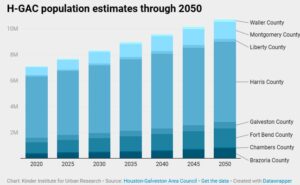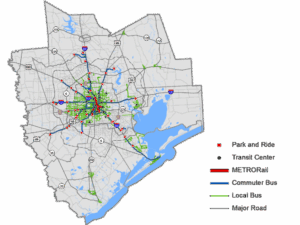As Greater Houston experiences rapid population growth, managing infrastructure demands and guiding sustainable development are essential to ensuring long-term resilience and a high quality of life. Addressing challenges like flooding, housing affordability, and mobility requires coordinated planning that links economic growth, workforce readiness, healthcare access, land use, and resilient infrastructure. By learning from successful regional models, Houston can shape a more connected and livable future.
Proactive Infrastructure Planning: A Regional Imperative
 The Houston region is projected to add millions of residents by 2050, fueling rapid growth that’s often concentrated in unincorporated areas where planning and service delivery struggle to keep pace. This surge underscores the urgent need for forward-thinking infrastructure investment to support expanding communities and maintain quality of life. Without coordinated efforts, critical systems—like roads, utilities, and transit—can become overwhelmed, leading to congestion, service disruptions, and reduced resilience.
The Houston region is projected to add millions of residents by 2050, fueling rapid growth that’s often concentrated in unincorporated areas where planning and service delivery struggle to keep pace. This surge underscores the urgent need for forward-thinking infrastructure investment to support expanding communities and maintain quality of life. Without coordinated efforts, critical systems—like roads, utilities, and transit—can become overwhelmed, leading to congestion, service disruptions, and reduced resilience.
Collaboration between public agencies and private stakeholders can drive strategic infrastructure improvements. Since Hurricane Harvey, flood mitigation has become a top priority, with the Harris County Flood Control District’s bond program and projects such as Project Brays and the Buffalo Bayou Community Plan demonstrating innovative approaches that blend engineering solutions with environmental restoration and community benefits.
Yet, many rapidly growing suburban and exurban areas—especially in northern Harris and Montgomery counties—highlight the risks when infrastructure investment lags behind development. These communities often grapple with overburdened utility systems, inadequate road networks, and limited transit options, all of which hinder mobility, safety, and access to essential services.
This reality makes regional collaboration critical. Coordination among cities, counties, municipal utility districts (MUDs), and special districts is necessary to align infrastructure expansion with population growth. Only through shared planning and investment can the Houston region build resilient, connected, and equitable communities capable of thriving well into the future.
Integrating Business, Education, Healthcare, and Mobility
A resilient Houston region depends on how well we connect economic growth with workforce development, healthcare access, and efficient transportation.
In west Houston, proximity to the Energy Corridor, Houston Methodist, Memorial Hermann, and Texas Children’s hospitals creates a unique live-work ecosystem. When coupled with institutions like the Houston Community College’s and University of Houston’s Katy campuses, which partners with local industries to prepare students for high-demand careers, the area becomes a model for integrating education and business in support of long-term prosperity.
 Mobility is a defining challenge in Houston’s continued expansion. As development pushes beyond the urban core, connecting people to jobs, healthcare, education, and other essential services becomes increasingly critical. Regional mobility planning will need to work towards addressing these needs. Houston METRO’s current plan takes important steps in addressing transit improvement along current routes, aiming to increase access and opportunity for communities where many residents rely on public transportation for daily life. While these improvements are vital, they must also be complemented by a broader regional vision. Communities outside Beltway 8—such as those in greater West Houston, Fort Bend, and Waller County—are among the fastest growing in the region, and they too face mounting mobility pressures. This is where METRO’s Park & Ride system can play a transformative role.
Mobility is a defining challenge in Houston’s continued expansion. As development pushes beyond the urban core, connecting people to jobs, healthcare, education, and other essential services becomes increasingly critical. Regional mobility planning will need to work towards addressing these needs. Houston METRO’s current plan takes important steps in addressing transit improvement along current routes, aiming to increase access and opportunity for communities where many residents rely on public transportation for daily life. While these improvements are vital, they must also be complemented by a broader regional vision. Communities outside Beltway 8—such as those in greater West Houston, Fort Bend, and Waller County—are among the fastest growing in the region, and they too face mounting mobility pressures. This is where METRO’s Park & Ride system can play a transformative role.
By strategically expanding Park & Ride facilities and routes, as well as engaging in increased regional collaboration, mass transit can help bridge the gap between outlying residential areas and job centers within the city. These hubs can serve as regional transit nodes, connecting growing suburban populations to METRO’s core network of bus and rail service, while also reducing traffic congestion, improving air quality, and supporting more sustainable land use.
Land Use, Amenities, and Quality Growth
With many Houston-area communities built under a market-driven, low-regulation model, integrating land use and infrastructure planning is key to developing resilient, quality communities.
 The West Houston Association’s 2060 Plan provides a framework for addressing these gaps by advocating for coordinated planning, walkable mixed-use centers, and green infrastructure. Places like Bridgeland and Towne Lake in northwest Harris County demonstrate how master-planned communities can successfully incorporate parks, trails, and community amenities into suburban growth.
The West Houston Association’s 2060 Plan provides a framework for addressing these gaps by advocating for coordinated planning, walkable mixed-use centers, and green infrastructure. Places like Bridgeland and Towne Lake in northwest Harris County demonstrate how master-planned communities can successfully incorporate parks, trails, and community amenities into suburban growth.
At the same time, retrofitting older areas—such as along Memorial Drive in Memorial City or inside the Beltway in Sharpstown—requires collaboration between property owners, public agencies, and residents. The goal is to improve connectivity, preserve character, and enhance public spaces without displacing longtime residents.
Designing Density for Livability
 Livable density in Houston means more than just adding housing—it requires access to green spaces, safe streets, and places for neighbors to gather. Projects like Emancipation Park in Third Ward, Memorial Park’s Eastern Glades, and the Bayou Greenways initiative demonstrate how investing in public space can transform urban life. As the Houston region expands—especially across its fast-growing suburbs—these same principles must guide development beyond the city core.
Livable density in Houston means more than just adding housing—it requires access to green spaces, safe streets, and places for neighbors to gather. Projects like Emancipation Park in Third Ward, Memorial Park’s Eastern Glades, and the Bayou Greenways initiative demonstrate how investing in public space can transform urban life. As the Houston region expands—especially across its fast-growing suburbs—these same principles must guide development beyond the city core.
The region faces a widening affordability gap, with housing costs outpacing wages near major job centers. Expanding diverse, higher-density housing is not just a design preference—it’s an economic imperative. Thoughtful density reduces land costs per unit, enabling a broader range of price points and helping prevent economic segregation that pushes lower-income residents farther from opportunity.
Suburbs from Fort Bend to Waller County are seeing rising demand for walkable, connected, mixed-use neighborhoods. The challenge isn’t whether to allow density—it’s how to design it to enhance, rather than diminish, quality of life. Livable density integrates green infrastructure, open spaces, and pedestrian-friendly streets, providing places to play, gather, and build community.
Quality higher-density development creates complete neighborhoods through thoughtful architecture, human-scaled streetscapes, and amenities like trails, plazas, and pocket parks that serve all ages. These elements foster community ownership and belonging. The City of Houston’s Walkable Places and Transit-Oriented Development guidelines are equally vital in suburban areas, to help emerging centers avoid car-dependent development.
 Developments like CityCentre and LaCenterra illustrate how density and design combine to create vibrant suburban hubs. Located at Beltway 8 and I-10 in suburban Houston, CityCentre is a dynamic mixed-use development in Houston that successfully combines residential, retail, office, and entertainment spaces into a vibrant, walkable community hub. Further southwest in unincorporated Fort Bend County, LaCenterra blends retail, dining, office, and residential in a walkable environment that encourages social interaction and reduces car reliance, proving that even traditionally car-centric suburbs can evolve toward livability.
Developments like CityCentre and LaCenterra illustrate how density and design combine to create vibrant suburban hubs. Located at Beltway 8 and I-10 in suburban Houston, CityCentre is a dynamic mixed-use development in Houston that successfully combines residential, retail, office, and entertainment spaces into a vibrant, walkable community hub. Further southwest in unincorporated Fort Bend County, LaCenterra blends retail, dining, office, and residential in a walkable environment that encourages social interaction and reduces car reliance, proving that even traditionally car-centric suburbs can evolve toward livability.
To the Northwest, Howard Hughes’ master-planned Bridgeland community in Cypress integrates denser townhome and mixed-use districts alongside trails, lakes, and parks. This layered design meets diverse housing needs while prioritizing green infrastructure, stormwater management, and habitat preservation, showing how density and environmental stewardship can go hand in hand.
These examples highlight that when thoughtfully designed and locally grounded, density becomes a catalyst for community identity, mixed-income housing, and improved access to services, supports mixed-income housing, improves service access, and strengthens community identity—even in unincorporated suburban areas.
As Houston’s growth pushes outward, these projects offer a new suburban paradigm—one where density means connection, sustainability, and shared prosperity, not congestion or compromise. With intentional planning and investment, livable density can be a solution that benefits the entire region.
Conclusion: A Blueprint for Our Region’s Future
The greater Houston region stands at a crossroads. As we face the realities of climate change, population growth, and economic uncertainty, we must embrace proactive planning that integrates infrastructure, housing, mobility, and public amenities. Our success depends on how we weave these elements together, not only to accommodate growth but to improve lives.
By learning from existing regional models and scaling up what works, we can chart a path toward more resilient, inclusive, and vibrant communities. Houston’s future doesn’t depend on whether we grow—but on how thoughtfully and sustainably we do so.
——————————————————————————————————
We encourage you to attend our upcoming QPD Symposium: Turning Growth Into Opportunity to learn more and continue this discussion!
